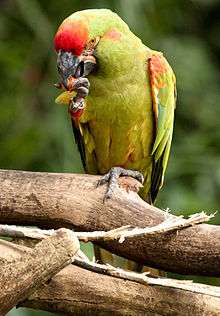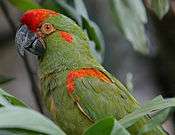Red-fronted macaw
| Red-fronted macaw | |
|---|---|
 | |
| At Tulsa Zoo, Oklahoma, USA | |
| Scientific classification | |
| Kingdom: | Animalia |
| Phylum: | Chordata |
| Class: | Aves |
| Order: | Psittaciformes |
| Superfamily: | Psittacoidea |
| Family: | Psittacidae |
| Subfamily: | Arinae |
| Tribe: | Arini |
| Genus: | Ara |
| Species: | A. rubrogenys |
| Binomial name | |
| Ara rubrogenys Lafresnaye, 1847 | |
The red-fronted macaw (Ara rubrogenys) is a parrot endemic to a small semi-desert mountainous area of Bolivia. It is an endangered species; it has been successfully bred in captivity, and is available, if not common, as a pet.
Description
The red-fronted macaw is 55–60 cm (21.5–23.5 in) long. It is mostly green, and has a red forehead, a red patch over the ears and bright red to orange edged under wing coverts. It has an area of pinkish skin around the eyes extending to the beak. It has red at the bend of wings and blue primary wing feathers.[2]
Range and habitat

The red-fronted macaw is native to a small mountainous area of south-central Bolivia situated about 200 km west of Santa Cruz, in the department of the same name, where the climate is medium altitude semi-desert. The natural vegetation consists mostly of cactus (large and small) and thorny trees and scrub. The climate is semi arid with cold nights and hot days. Rain comes in infrequent heavy storms. It is unusual in that it is the only macaw to inhabit such a climatic zone. Most macaws nest in holes in large trees, however here there are no very large trees in its range so it nests in vertical fissures in cliff faces.[3] The bird has been captured for the pet trade in the past and killed by local farmers because it raids their crops.

Plumage
 Upper body
Upper body Head
Head Side – Jurong BirdPark, Singapore
Side – Jurong BirdPark, Singapore_-on_branch-3cp.jpg) Wing clipped
Wing clipped In the air
In the air Flying
Flying
References
- ↑ BirdLife International (2013). "Ara rubrogenys". IUCN Red List of Threatened Species. Version 2013.2. International Union for Conservation of Nature. Retrieved 26 November 2013.
- ↑ "Species factsheet: Ara rubrogenys". BirdLife International (2008). Retrieved 24 July 2008.
- ↑ Lanning, D (1991). "Distribution and breeding biology of the Red-fronted Macaw" (PDF). Wilson Bulletin. 103 (3): 357–365.
External links
- Red-fronted macaw videos on the Internet Bird Collection
- Stamps (for Bolivia)
- Red-fronted macaw photo gallery VIREO
- Wild macaws (Bolivia section)
